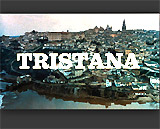
|
Tristana (1970, Fr./It./Sp.)
In Luis Bunuel's coming-of-age drama about obsession,
hypocrisy, religion (Catholicism) and sex, described in its tagline
as: "Somewhere between the innocent girl and the not-so-innocent
mistress is the bizarre, sensuous story of Tristana" - similar
in theme to Bunuel's own Viridiana (1961), and his final film That
Obscure Object of Desire (1977), as well as Kubrick's Lolita
(1960):
- the title character in 1920s-1930s Toledo, Spain:
young teenaged and orphaned Tristana (Catherine Deneuve), and placed
under the guardianship of elderly, respectable, but decadent, atheistic
and sexually-perverted aristocrat-nobleman Don Lope Garrido (Fernando
Rey), a free-thinking Socialist and philanderer [Note: it was entirely
possible that Tristana was his own child - her deceased mother
was one of Don Lope's lovers]
- the surrealistic dreamy nightmare of Tristina in a
bell tower, where she experienced the "horrific" sight
of Don Lope's amputated head seen as a bell clapper swinging back
and forth - sounding the bell; awakening in a fright, Don Lope came
to her bedside to console her
- the development of an over-protective, sexually-abusive,
over-possessive, father/lover-daughter relationship between the two;
the sex scenes between them (off-screen) were hidden behind closed
doors
- the sequences of mistress Tristana's feeling of entrapment
and her search for freedom, found in love for studly young painter
Horatio (Franco Nero); she told him: "Do you think I don't loathe
my life as a slave? I want to be free, to work" - subsequently,
she departed from Don Lope for two years to Madrid
- the sequence of Tristana's forced return to a wealthier
Don Lope, after suffering a painful, malignant terminal tumor on
her right leg, forcing expensive surgery and amputation
- the erotic scene of Tristana's preparation to exhibit
herself from her second-floor balcony to Saturno (Jesus Fernandez)
- her third lover in the film - the mute teenage son of Don Lope's
maid Saturna (Lola Gaos); she laid her prosthetic leg on her bed
covered with articles of lingerie and undergarments that she had
removed, before she emerged on the outdoor terrace; after Saturno
signaled for her to open her clothing, she exposed herself by opening
her dress and flashing her breasts (off-screen) - with a smile
- the sequence of Don Lope's and Tristana's church
marriage - after Don Lope had asked for and received the embittered
and vengeful Tristana's permission to marry; before marriage, she
had admitted to local priest Don Ambrosio (Vicente Soler): "How
can I marry him, if I can't stand the sight of him?"; Ambrosio
urged: "You have to overcome that unhealthy passion. When
he was really doing you harm, you accepted it without a word. And
now, when he's behaving so well with you... What more can you ask
for?"; she replied: "The better he is, the less I love
him"
- the dramatic reversal of personalities in their tragic
relationship, now that they were legally tied together: the mellowing,
increased religiosity, kindness, and respectfulness of Don Lope,
and the cold, God-less, unforgiving bitterness, hard-heartedness
and self-destructiveness of Tristana
- other examples of foot fetishism in Bunuel's film:
early in the film, the instances when young Tristana would put on
Don Lope's shoes for him; and much later, a view of her exposed right
leg nub beneath her skirt as she played the piano and worked the
foot pedal with her left leg
|
Emotionally-Crippled, Vengeful and Deformed
|

|

|

|
- the concluding scene on a snowy winter night: the
cruel death of Don Lope ultimately from pneumonia, deliberately
caused by Tristana, who pretended to call a doctor for him from
the adjoining room, and then opened his balcony doors to expose
him to the cold air
- the ending: a quick succession or series of replays
of key moments from the film, unreeling the story backwards in a
kind of narrative zoom to the first view of Tristana in the opening
scene
|










|











